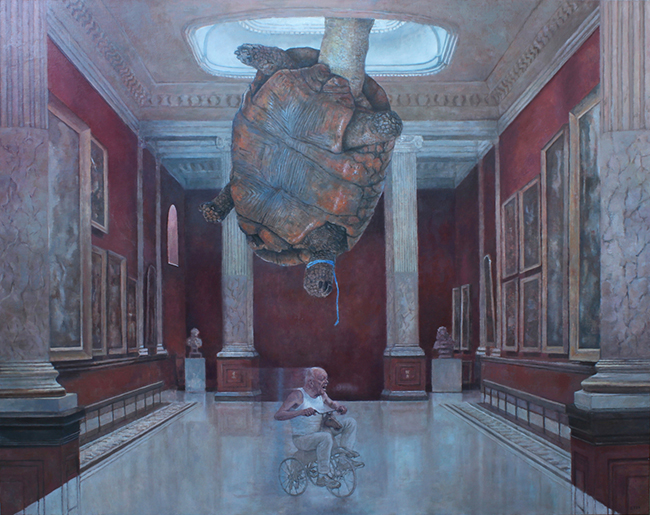Erik Tierolf was born in 1963 in Renesse, a seaside town in the Dutch province of Zeeland. He grew up in Emmen, far from the ocean, and the contrast between those two environments—open coastlines and the quiet rhythm of inland towns—might say something about the way his work balances stillness and tension. He studied at the AKI Art Academy between 1982 and 1987, during a time when Dutch art was shifting, stretching out from traditional forms into broader conversations with European surrealism and conceptual play. Tierolf absorbed those shifts and then went his own way.

After a brief time in the south of France—another place where history and light seem to hang in the air—he landed in Amsterdam, then eventually moved north to Bergen. That’s where he still works today. The town is known for its long-standing community of artists, and it suits Tierolf’s quiet, reflective approach. But the work itself doesn’t stay quiet. It moves. It provokes. It lingers.
Tierolf’s paintings lean toward the surreal. But they aren’t just dreamscapes. They’re questions. Scenarios that hover somewhere between fable and farce. Take his oil painting Floating, which measures 180 by 140 centimeters. At first glance, it’s bizarre: a massive tortoise dangles upside down from the ceiling of a stately museum hall. Below it, an elderly man pedals a child’s tricycle across the floor. The scene is calm, even oddly dignified, but the absurdity sticks with you. Why is the tortoise suspended? Why the tricycle? Who is the man?
Tierolf doesn’t offer answers. He builds these scenarios and then lets them breathe. The viewer fills in the rest—or doesn’t. That space between the image and its meaning is part of the experience.
What stands out in his work is his control. His oil technique is traditional—careful layering, rich tones, attention to light—but what he paints is anything but classical. In that contrast, the tension lives. The paintings feel like a lucid dream: precise and detailed, but slippery in logic. His museum settings, recurring in several works, suggest reverence, permanence, and history. But the inhabitants of those spaces—animals, strange contraptions, lonely characters—undermine the sense of order. Something always feels off-kilter.
There’s often humor in his work, but it’s not easy humor. It’s dry, sometimes bleak, like the joke lands just after you realize the weight of it. A tricycle under an old man. A giant reptile tied to architecture. There’s something about youth and age, movement and stasis, captivity and memory. The tension works because it’s never overstated. Tierolf doesn’t push emotion. He lets the quiet oddness do the work.
Over the years, his work has traveled far. Exhibitions in Amsterdam, Rotterdam, The Hague. Shows in Frankfurt, Paris, Barcelona, New York. Participation in international art fairs has brought Tierolf into wider conversations, but his style remains distinct. You get the sense that no matter the setting, his work returns to certain personal questions: what is real, what is remembered, what is imagined?
Though rooted in oil painting, Tierolf doesn’t box himself in. His approach is versatile. Some works lean more heavily into satire. Others, more quietly into melancholy. He plays with scale, juxtaposition, and time. His imagery is often symbolic but never in a heavy-handed way. You’re not forced into interpretation. You’re invited to dwell in it.
His background in the Netherlands, a country that’s long juggled nature and structure, light and shadow, likely informs his visual language. Dutch painting has a deep history of observation—landscapes, interiors, human detail. Tierolf folds that heritage into his more surreal narratives. In doing so, he bridges past and present, realism and illusion.
Bergen, where he lives now, has long been a haven for painters. The landscape there—sand dunes, sea winds, soft northern light—has a way of seeping into the work of artists who live there. It’s not hard to imagine Tierolf pulling in those natural rhythms while building the internal rhythms of his own visual world.
Ultimately, Tierolf’s art invites a kind of slow looking. Not everything is revealed in the first glance. The scenes seem humorous, even playful, but beneath them is a deeper disquiet. His work asks you to linger in discomfort, to sit with the surreal, to find meaning in the offbeat.
And maybe that’s the point. Not to decode it all, but to stay in the tension—between childhood and old age, between movement and stillness, between what we see and what we think we understand.

